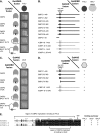Role of the C-terminal binding protein PXDLS motif binding cleft in protein interactions and transcriptional repression
- PMID: 16940173
- PMCID: PMC1636740
- DOI: 10.1128/MCB.00445-06
Role of the C-terminal binding protein PXDLS motif binding cleft in protein interactions and transcriptional repression
Abstract
C-terminal binding proteins (CtBPs) are multifunctional proteins that can mediate gene repression. CtBPs contain a cleft that binds Pro-X-Asp-Leu-Ser (PXDLS) motifs. PXDLS motifs occur in numerous transcription factors and in effectors of gene repression, such as certain histone deacetylases. CtBPs have been depicted as bridging proteins that self-associate and link PXDLS-containing transcription factors to PXDLS-containing chromatin-modifying enzymes. CtBPs also recruit effectors that do not contain recognizable PXDLS motifs. We have investigated the importance of the PXDLS binding cleft to CtBP's interactions with various partner proteins and to its ability to repress transcription. We used CtBP cleft mutant and cleft-filled fusion derivatives to distinguish between partner proteins that bind in the cleft and elsewhere on the CtBP surface. Functional assays demonstrate that CtBP mutants that carry defective clefts retain repression activity when fused to heterologous DNA-binding domains. This result suggests that the cleft is not essential for recruiting effectors. In contrast, when tested in the absence of a fused DNA-binding domain, disruption of the cleft abrogates repression activity. These results demonstrate that the PXDLS binding cleft is functionally important but suggest that it is primarily required for localization of the CtBP complex to promoter-bound transcription factors.
Figures






Similar articles
-
Specific recognition of ZNF217 and other zinc finger proteins at a surface groove of C-terminal binding proteins.Mol Cell Biol. 2006 Nov;26(21):8159-72. doi: 10.1128/MCB.00680-06. Epub 2006 Aug 28. Mol Cell Biol. 2006. PMID: 16940172 Free PMC article.
-
Structural determinants outside the PXDLS sequence affect the interaction of adenovirus E1A, C-terminal interacting protein and Drosophila repressors with C-terminal binding protein.Biochim Biophys Acta. 2001 Mar 9;1546(1):55-70. doi: 10.1016/s0167-4838(00)00071-6. Biochim Biophys Acta. 2001. PMID: 11257508
-
Association of COOH-terminal-binding protein (CtBP) and MEF2-interacting transcription repressor (MITR) contributes to transcriptional repression of the MEF2 transcription factor.J Biol Chem. 2001 Jan 5;276(1):35-9. doi: 10.1074/jbc.M007364200. J Biol Chem. 2001. PMID: 11022042
-
The CtBP family: enigmatic and enzymatic transcriptional co-repressors.Bioessays. 2001 Aug;23(8):683-90. doi: 10.1002/bies.1097. Bioessays. 2001. PMID: 11494316 Review.
-
Transcriptional regulation by C-terminal binding proteins.Int J Biochem Cell Biol. 2007;39(9):1593-607. doi: 10.1016/j.biocel.2007.01.025. Epub 2007 Feb 4. Int J Biochem Cell Biol. 2007. PMID: 17336131 Review.
Cited by
-
Nicotinamide adenine dinucleotide-induced multimerization of the co-repressor CtBP1 relies on a switching tryptophan.J Biol Chem. 2013 Sep 27;288(39):27836-48. doi: 10.1074/jbc.M113.493569. Epub 2013 Aug 12. J Biol Chem. 2013. PMID: 23940047 Free PMC article.
-
An ARF/CtBP2 complex regulates BH3-only gene expression and p53-independent apoptosis.Cell Death Differ. 2010 Mar;17(3):513-21. doi: 10.1038/cdd.2009.140. Epub 2009 Oct 2. Cell Death Differ. 2010. PMID: 19798104 Free PMC article.
-
KLF feedback loops in innate immunity.Front Immunol. 2025 Jun 4;16:1606277. doi: 10.3389/fimmu.2025.1606277. eCollection 2025. Front Immunol. 2025. PMID: 40534851 Free PMC article. Review.
-
The intracellular NADH level regulates atrophic nonunion pathogenesis through the CtBP2-p300-Runx2 transcriptional complex.Int J Biol Sci. 2018 Nov 3;14(14):2023-2036. doi: 10.7150/ijbs.28302. eCollection 2018. Int J Biol Sci. 2018. PMID: 30585266 Free PMC article.
-
The Role of CtBP1 in Oncogenic Processes and Its Potential as a Therapeutic Target.Mol Cancer Ther. 2017 Jun;16(6):981-990. doi: 10.1158/1535-7163.MCT-16-0592. Mol Cancer Ther. 2017. PMID: 28576945 Free PMC article. Review.
References
-
- Balasubramanian, P., L. J. Zhao, and G. Chinnadurai. 2003. Nicotinamide adenine dinucleotide stimulates oligomerization, interaction with adenovirus E1A and an intrinsic dehydrogenase activity of CtBP. FEBS Lett. 537:157-160. - PubMed
-
- Barnes, C. J., R. K. Vadlamudi, S. K. Mishra, R. H. Jacobson, F. Li, and R. Kumar. 2003. Functional inactivation of a transcriptional corepressor by a signaling kinase. Nat. Struct. Biol. 10:622-628. - PubMed
-
- Brannon, M., J. D. Brown, R. Bates, D. Kimelman, and R. T. Moon. 1999. XCtBP is a XTcf-3 co-repressor with roles throughout Xenopus development. Development 126:3159-3170. - PubMed
-
- Chinnadurai, G. 2006. CtBP family proteins: unique transcriptional regulators in the nucleus with diverse cytosolic functions. In G. Chinnadurai (ed.), CtBP family proteins. Landes Biosciences, Georgetown, Tex. [Online.] http://eurekah.com/chapter.php?chapid=2824&bookid=198&catid=30.
Publication types
MeSH terms
Substances
Grants and funding
LinkOut - more resources
Full Text Sources
Other Literature Sources
Molecular Biology Databases
